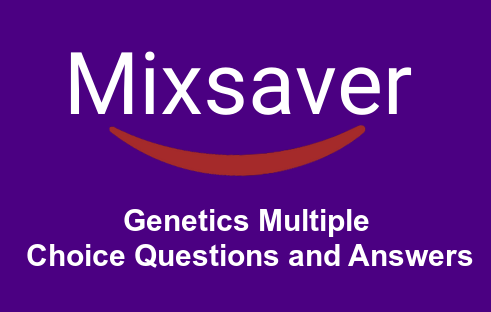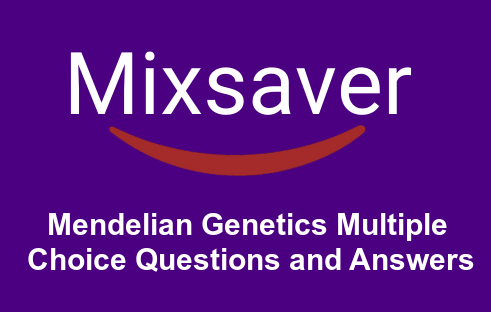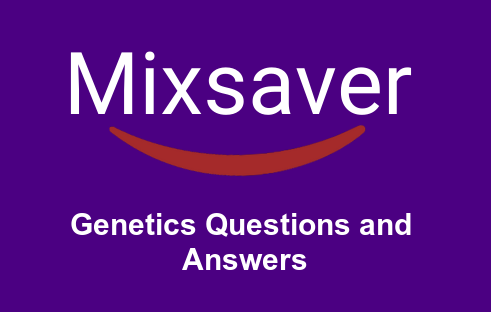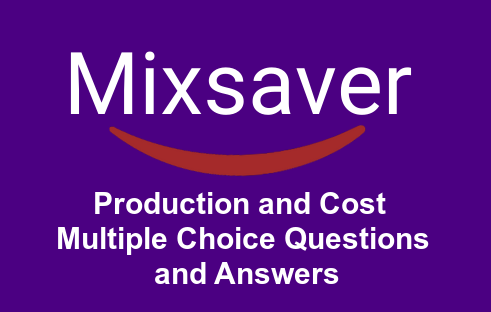Quiz on chromosomal abnormalities | chromosomal aberrations mcq questions | Mutation & Chromosomal Abberation
1. A segment of the DNA has a base sequence AAG GAG GAC CAA CCA, which of the following sequences represents a frameshift mutation?
(a) AGG AGG ACC AAC CA
(b) AAG GCG G?C CCA AC
(c) ACG GAC G?C CAG CCA
(d) AAG GAG GAC CAA CCA
Ans. a
2. Who has introduced X-ray mutations in barley and maize?
(a) Stadler
(b) Muller
(c) Morgan
(d) All of these
Ans. a
3. If the DNA codons are ATG ATG ATG and a cytosine base is inserted at the beginning, which of the following will result?
(a) CA TGA TGA TG
(b) CATG ATG ATG
(c) CAT GAT GATG
(d) A non-sense mutation
Ans. c
4. If a mutation occurs in a gamete, it would influence
(a) only a single individual
(b) sterility in the progeny
(c) all successive generation of the parents
(d) only the particular sex of the progeny, whose gamete had undergone mutation
Ans. c
5. ZO-ZZ type of sex determination is
(a) opposite of XX-XO
(b) opposite of XX-XY
(c) opposite of ZZ-ZW
(d) None of these
Ans. a
6. Which one of the following is not an example of chromosomal disorder?
(a) Down’s syndrome
(b) Turner’s syndrome
(c) Klinefelter’s syndrome
(d) None of these
Ans. d
7. Any change during cell division that results in loss or gain of one or more chromosomes is known as
(a) aneuploidy
(b) euploidy
(c) monopioidy
(d) hypoploidy
Ans. a
8. X-chromosome is
(a) telocentric
(b) metacentric
(c) acrocentric
(d) acentric
Ans. b
9. A mutant rice is
(a) allopolyploid
(b) autopolyploid
(c) autoallopolyploid
(d) segmental polypioid
Ans. c
10. The site of the gene, at which the mutations occur with usually high frequency are
(a) recons
(b) hot spots
(c) mutons
(d) palindromes
Ans. b
11. Type of gene mutation which involves the replacement of purine with pyrimidine or vice versa or the substitution of one type of base with another type of base is
(a) transition
(b) transduction
(c) translation
(d) transversion
Ans. d
12. The gene that controls the rate of mutation of another gene is
(a) mutator gene
(b) inducer gene
(c) mutable gene
(d) regulator gene
Ans. a
13. Which of the following will cause a more effective mutation?
(a) One codon
(b) One base deletion
(c) Base substitution
(d) Base deamination
Ans. b
14. A single gene mutation affecting more than one phenotype is called
(a) azotrophic
(b) pleiotropic
(c) auxotropic
(d) pleiotrophic
Ans. b
15. A mutation that change a codon specifying one amino acid to a termination codon is called
(a) mis sense mutation
(b) transition mutation
(c) non-sense mutation
(d) frameshift mutation
Ans. c
16. Tendency of genes to get inherited together is called
(a) differential inheritance
(b) sex linkage
(c) linkage
(d) None of these
Ans. c
17. Exchange of segments between non-homologous chromosome is called
(a) crossing over
(b) inversion
(c) duplication
(d) translocation
Ans. d
18. Father of Neurospora genetics (haploid genetics) is
(a) Lindegren
(b) Dodge
(c) Morgan
(d) Muller produced
Ans. b
19. Hereditary variations in plants have been produced by the use of
(a) DDT
(b) auxins
(c) X-rays
(d) gibberellic acid
Ans. a
20. Which of the following is a type of base pair mutation?
(a) Deletion
(b) Insertion
(c) Transitions
(d) None of these
Ans. c
21. Recessive mutations are expressed normally in
(a) heterozygous condition
(b) homozygous condition
(c) neither in homozygous nor in a heterozygous condition
(d) Both (a) and (b)
Ans. b
22. Mutations are mainly responsible for
(a) increasing population rate
(b) maintaining genetic continuity
(c) controlling variation in organisms
(d) controlling extinction of organisms
Ans. c
23. A frameshift mutation could result from
(a) a base deletion only
(b) a base insertion only
(c) either an insertion or a deletion of base
(d) deletion of three consecutive bases
Ans. c
24. Inheritable mutations can be studied by
(a) pure line breeding
(b) Punnett square
(c) using chemical mutagens
(d) generating a pedigree of a family
Ans. a
25. Exchange of genetic material from non-sister chromatid is called
(a) transformation
(b) crossing over
(c) translocation
(d) deletion
Ans. b
26. Sex chromosome of a female bird are represented by
(a) XO
(b) XX
(c) XY
(d) ZW
Ans. d
27. Genes when combined together on a chromosome are known
(a) linkage
(b) mutation
(c) translation
(d) transcription
Ans. a
28. Frameshift mutation occurs when
(a) base is deleted
(b) base is added
(c) base is added or deleted
(d) None of the above
Ans. c
29. Sex-chromosomes of a male silkworm is
(a) X
(b) y
(c) XX
(d) XY
Ans. c
30. Which one is caused by the mutation in animals?
(a) Change in habit
(b) Change in Golgi body
(c) Change in gene structure
(d) Change in peroxysome
Ans. c
31. A well known autosomal abnormality at birth is
(a) Klinefelter’s syndrome
(b) Down’s syndrome
(c) Patau’s syndrome
(d) Turner’s syndrome
Ans. b
32. The genetic defect deficiency can be cured permanently by Adenosine Deaminase (ADA)
(a) the enzyme replacement therapy
(b) periodic infusion of genetically engineered lymphocytes having functional ADA CDNA
(c) introducing bone marrow cells producing ADA into cellsat early embryonic stages
(d) administering adenosine deaminase activators
Ans. c
mcq on aneuploidy | mutation multiple choice questions and answers pdf
33. Of a normal couple, half the sons are haemophilic while half the daughters are carriers. The gene is located in
(a) X- chromosome of father
(b) Y-chromosome of father
(c) one X chromosome of mother
(d) Both X-chromosomes of mother
Ans. c
34. Of both normal parents, the chance of a male child becoming colourblind are
(a) no
(b) possible only when all four grand parents had normal vision
(c) possible only when father’s mother was colourblind
(d) possible only when mother’s father was colourblind
Ans. d
35. A fruitfly is heterozygous-for sex-linked genes when mated with normal female fruit fly, the males specific chromosome will enter egg cell in the proportion.
(a) 3:1
(b) 7:1
(c) 1:1
(d) 2:1
Ans. c
36. Which of the following disease sets an example of pleiotropy?
(a) Haemophilia
(b) Thalassemia
(c) Sickle cell anaemia
(d) Colour blindness
Ans. c
37. XY sex chromosomes were discovered by
(a) Mendel
(b) R Brown
(c) Nettie Stevens
(d) MJD White
Ans. c
38. XX male and XY females are very few in humans. They are due to
(a) genes of Y- chromosomes are on X- chromosome
(b) crossing over between X and Y
(c) Non disjunction of chromosomes
(d) All of the above
Ans. a
39. Genes located on Y-chromosome are
(a) autosomal genes
(b) sex influential genes
(c) holandric genes
(d) Mutant genes
Ans. c
40. One of the genes present exclusively on X-chromosome in humans is concerned with the
(a) baldness
(b) ved green colour blindness
(c) night blindness
(d) None of these
Ans. b
41. Genic balance theory of sex determination was given by
(a) Morgan
(b) Bridges
(c) Darwin
(d) Mendel
Ans. b
42. Sex determination was first of all studied in which plant?
(a) Rumex
(b) Datura
(c) Mirabilis
(d) Melandrium
Ans. d
43. The probability that a male inherited his Y-chromosome from his maternal grand father is
(a) 0%
(b) 25%
(c) 50%
(d) 100%
Ans. a
44. Which one of the following genetic condition is n sex-linked?
(a) Ichtyosis
(b) Colour blindness
(c) Sickle cell anaemia
(d) Both (a) and (c)
Ans. c
45. A women whose brother has haemophilic is concerned about passing this trait to her offspring. What is the risk that she will have a son with haemophilia?
(a) 1/8
(b) 1/4
(c) 1/2
(d) 1
Ans. b
46. Can a male be a carrier for a sex-linked disease?
(a) Yes, if the trait is recessive
(b) Yes, if the male’s father and mother were carriers
(c) No, males have only a single copy of sex-linked genes
(d) No way to predict
Ans. c
47. X-inactivation can be used to identify individuals who are
(a) homozygous unaffected
(b) heterozygous
(c) homozygous affected
(d) Missing X-linked genes
Ans. b
48. Beard growth in humans is an example of a …. trait.
(a) sex linked
(b) sex influenced
(c) sex limited
(d) Y- linked
Ans. c
49. What would be the sex of an xxy individual?
(a) Male
(b) Female
(c) Hermaphrodite
(d) Mosaic
Ans. a
50. A female whose father was colourblind marries a normai male whose father was also colourblind. What is the probability that their son will be colour blind?
(a) 0%
(b) 25%
(c) 50%
(d) 75%
Ans. c





